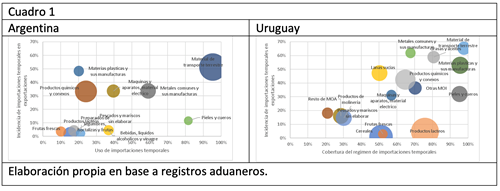
All countries work hard to be able to export their national production. As is well recorded in international trade literature, reaching new markets allows countries to exploit gains in scale and specialization, among other benefits, which are a vehicle to boost productivity and welfare of society. However, a key factor for export capacity is having access to quality inputs, which allows products to compete in international markets.
Many times these inputs can be obtained in the domestic market, and this promotes productive chains that further boost trade profits. On many other occasions, however, certain inputs necessary for production are not readily available in the local market, which means that they must be imported from other countries. This in no way reduces trade profits; on the contrary, it allows these businesses that would otherwise could not produce goods with the necessary export quality, to produce them and access international markets. Therefore, in these cases, import is a fundamental component of exports.
During the 20th century, with the progress in the signing of preferential trade agreements that reduced tariffs in the countries, the trade of inputs also became more dynamic, which contributed greatly to the fragmentation of production and the boom of global value chains, i.e., productive processes where different stages of production take place in different countries. However, the countries that actively participate in these chains are generally large exporters, but also large importers, because they add value at one stage of the production process.
In order to study these productive links, in the document “Imports for export and value chains in Argentina and Uruguay” we study the share of imports in exports of different sectors of the economy of Argentina and Uruguay, using customs data for temporary import regimes. These regimes, present in many of the countries of the region, set tariff exemptions on imported inputs that will be used to produce goods for export. As companies declare the use and destination of the input, it is possible to analyze how relevant imported inputs are for the exports of these businesses.
For the analysis, we built two measures in order to better understand the use of imported inputs. First, coverage measures the proportion of exports using the regime. The other indicator is incidence, which measures the ratio between the value of imported inputs and the value of the exported good. These two indicators offer an approximate value of the level of use of regimes and the intensity of use.

Graph 1 shows on the horizontal axis the coverage and on the vertical axis the incidence in the use of these regimes by sector for Argentina (panel A) and for Uruguay (Panel B), while the size of the bubbles represents the export value of the sector. As can be seen, there are sectors such as land transport equipment, base metals and their by-products or machines, and electrical equipment, where the use of the temporary import regime is very important. Taking the case of land transport material, almost all of the exports were made under this mechanism.
In turn, imported inputs account for between 50% and 70% of the value exported. In other words, for these companies, the use of imported inputs is widespread, and these inputs represent a significant portion of the exported value. This use of imported inputs allows these companies to produce high-quality goods and export them to other countries in the region and the world. There are other sectors, more closely related to agriculture, such as fresh fruits, where the use of these regimes is lower and the share of the imported value in the exported value is small, and therefore imports are less relevant in the exported value.
In summary, there are export sectors for which access to imported inputs is key to their ability to access international markets. High import tariffs reduce their competitiveness vis-à-vis foreign companies, thus reducing export benefits, and discouraging these foreign sales. The relevance of imported inputs is heterogeneous between sectors, with industrial manufacturing generally using most of them.

Lian Allub
Economista Principal, Dirección de Investigaciones Socioeconómicas, CAF -banco de desarrollo de América Latina-
Latest news:
-
Bahamas, Dominica and Grenada to join CAF
March 07, 2024
-
Latin America propose solutions to gain global relevance
January 31, 2024
-
CAF will gather more than 35 international experts at its Conference
January 26, 2024
